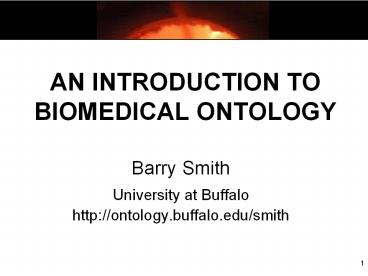AN INTRODUCTION TO BIOMEDICAL ONTOLOGY - PowerPoint PPT Presentation
Title:
AN INTRODUCTION TO BIOMEDICAL ONTOLOGY
Description:
* * Integration of biomedical data will never be achieved through integration of meanings or concepts because different user ... the biologically ... – PowerPoint PPT presentation
Number of Views:295
Avg rating:3.0/5.0
Title: AN INTRODUCTION TO BIOMEDICAL ONTOLOGY
1
AN INTRODUCTION TO BIOMEDICAL ONTOLOGY
- Barry Smith
- University at Buffalo
- http//ontology.buffalo.edu/smith
2
Uses of ontology in PubMed abstracts
3
The problem
- There are many ways to create databases,
creating silos - Multiple terminologies will not solve these silo
problems - We need to constrain terminologies so that they
converge - How?
4
Evidence-based terminology development
- Q What is to serve as constraint?
- A Reality, as revealed by experimentally based
science
5
The Gene Ontology
an example from the Gene Ontology
6
(No Transcript)
7
One aspect of the problem
how link different ontologies together? how
ensure that they are developed in tandem?
8
Things and processes exist in time in different
ways
substance
9
Continuants vs occurrents
- In preparing an inventory of reality
- we keep track of these two different kinds of
entities in two different ways
10
The very top
Continuant
Occurrent (always dependent on one or more
independent continuants)
Independent Continuant
Dependent Continuant
molecular function
cellular component
biological process
11
- Continuant entities
- - have continuous existence in time
- - preserve their identity through change
- Occurrent entities
- - have temporal parts
- - exist only in their phases/stages
12
You are a substance
- Your life is a process
- You are 3-dimensional
- Your life is 4-dimensional
13
Dependent entities
- require independent continuants as their bearers
- There is no run without a runner
- There is no grin without a cat
14
Dependent continuants
- Functions, qualities, roles
15
Qualities
- are dependent continuants
- temperature
- weight
- height
- color
16
Realizable dependent continuants
- function
- role
- disposition
17
Realizations are processes
- the expression of a function
- the exercise of a role
- the realization of a disposition
18
All occurrents are dependent on their
bearers/participants
- One-place vs. relational processes
- One-place processes
- a things getting warmer
- a things getting hungrier
19
Relational processes
- fusings, signallings, capturings
- bearers joined together into collectives of
greater or lesser duration
20
Part-Whole
Basic relation on the level of particulars
Johns heart is part of John Johns death is part
of Johns dying
21
Relations crossing the continuant-occurrent
border are never part-relations
Johns life
22
Parts of processes are always processes
thing
process
23
is_a A is_a B def. A is more specific
in meaning than B
- meningitis is_a disease of the nervous system
- unicorn is_a one-horned mammal
- cancer documentation is_a cancer
24
The problem
- We need to constrain terminologies so that they
converge - How?
25
Integration of biomedical data
- will never be achieved through integration of
meanings or concepts - because different user communities use different
concepts - and express them in uncontrolledly different ways
26
Kinds of relations
- lttype, typegt is_a, part_of, ...
- ltparticular, typegt this explosion instance_of
the type explosion - ltparticular, particulargt Marys heart part_of
Mary
27
part_of
- as a relation between particulars
- as a relation between types
28
- part_of
- for continuant types is time-indexed
- A part_of B def.
- given any particular a and any time t,
- if a instantiates A at t,
- then there is some particular b
- such that b instantiates B
- and a is an part_of b at t on the level of
particulars
29
derives_from (ovum, sperm ? zygote ... )
C1 c1 at t1
C c at t
time
C' c' at t
30
Advantages of the methodology of enforcing
commonly accepted coherent definitions
- promote quality assurance (better coding)
- promote automatic reasoning across ontologies
and across data at different granularities
31
(No Transcript)
32
Are pathways continuants or occurrent?
- what happens if we take the definitions from
google and classify the biologically relevant
cases into two groups, according to whether they
implied that pathways are continuants (roughly
the road travelled) or occurrents (the actual
travelling event)?
33
continuant
- nerve pathway a bundle of myelinated nerve
fibers following a path through the brain - a trodden path (wordnet.princeton.edu/perl/webwn
) - Network of interacting proteins used to carry out
biological functions such as metabolism and
signal transduction. www.inproteomics.com/nwglospq
.html - The physical course a chemical or pollutant takes
from its source to the exposed organism.
www.waterquality.de/hydrobio.hw/PTERMS.HTM - The "route" a hazardous substance takes from its
point of release (the "target") to a person,
plant or animal (the "receptor").
www.deq.state.or.us/wmc/cleanup/glossary.htm - A series of consecutive valid linkages in a
Pathways Diagram. www.ceaa-acee.gc.ca/013/0001/000
4/a_e.htm - Potential route for exposure to radioactive or
hazardous materials. www.comrad.org/glossary/glos2
.htm - The path traced as movement proceeds through
space. A pathway may be either on the floor or
through the air and is constructed of straight
and/or curved lines. www.ncpublicschools.org/curri
culum/artsed/scos/dance/glossary - The route along which a chemical substance or
hazardous material moves in the environment
www.ec.gc.ca/etad/csmwg/pub/fed_aprch/en/glossary_
e.htm
34
occurrent
- 1. A series of related biochemical
reactions. - www.genpromag.com/GlossaryLETTERP.html
- 2. Process for how patient moves through
continuum of care. There may be multiple
guidelines for a patient, depends on what you are
managing. Workflow management describes what is
done, how, by whom, and with what means. - informatics.medicine.dal.ca/w4/glossary.html































